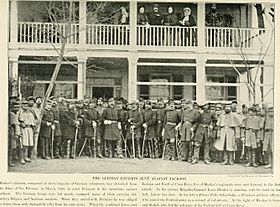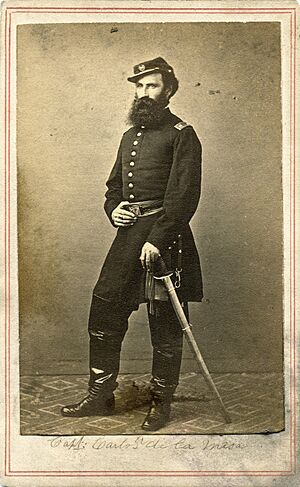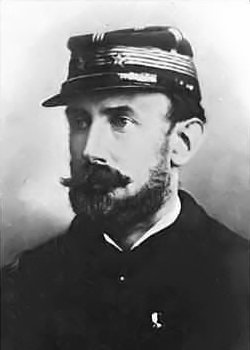Foreign enlistment in the American Civil War facts for kids
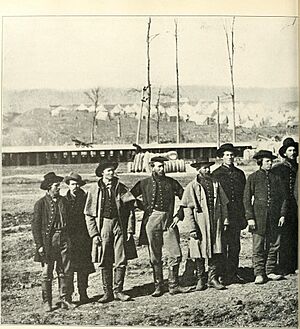
The American Civil War (1861–1865) was a big deal around the world. Many countries and people watched it closely. The United States was a new country back then. The main reason for the war was slavery, which was a huge issue everywhere. Because of this, many men from other countries joined the fight. Many immigrants living in the U.S. also joined.
When the war started, about 13% of Americans were born in other countries. Most of these people lived in cities in the North. So, most foreign soldiers joined the Union. The Union was also much better at getting volunteers.
About one-fourth to one-third of the Union Army was made up of foreign-born soldiers. This was about 543,000 to 625,000 out of 2 million troops. Another 18% had at least one parent born abroad. This means almost half of the Northern army had some foreign background. In contrast, only a few thousand foreigners fought for the Confederacy. They made up only 5% of its soldiers. This large number of foreign soldiers helped the Union win the war. Some historians even say the North might not have won without them.
Many immigrants came to the U.S. before the war. So, the largest groups of foreign soldiers were German, Irish, and British. This included English, Scottish, and Welsh people. Other foreign recruits came from Canada and other parts of Europe. These included Poland, France, Italy, and Scandinavia. Smaller groups came from China, Mexico, Hawaii, and Native American tribes. Some important leaders in both armies were also from foreign backgrounds.
Foreigners and immigrants fought for many reasons, just like American citizens. Some were against slavery. Others felt loyal to their new home country. Some were looking for a chance to make a better life. Most foreign soldiers fought bravely and loyally. However, they sometimes faced prejudice. This was because of their background, religion, or nationality. Some people in the Union tried to play down the immigrants' help. This was partly because the Confederacy spread rumors. They said the Union was using "foreign mercenaries" as cannon fodder.
Contents
Why Foreigners Joined the War
In the 40 years before the war, four million immigrants came to the United States. Most came from Ireland (one million), German states (500,000), and Great Britain (300,000). By 1860, more than one-tenth of all Americans were foreign-born. Many others were second- or third-generation immigrants. This led to a big change in the country's population. In 1800, the U.S. had about five million people. By 1860, it had grown to about 31 million.
The northern states had more cities and factories. They attracted most of the new immigrants. This gave the Union a big advantage over the Confederacy. Two-thirds of all Americans (21 million) lived in Union-controlled areas. This included 91% of all immigrants who came before the war. After the Southern states left, immigrants made up over half of the U.S. population. So, the North recruited most of the foreigners who fought in the Civil War.
Many immigrants, especially from Ireland, were escaping hard times. They fled famine and persecution. A large number, especially from German lands, came after big political changes in Europe in 1848. Many new arrivals believed in republican ideas. They strongly opposed any kind of political oppression, including slavery. They saw similarities between slavery and the exploitation of peasants in Europe. So, many immigrants strongly supported the Union. They joined the war for these important reasons.
Union Army: Foreign Soldiers
The Union worked hard to get foreigners to join. They recruited both in the U.S. and abroad. One recruitment poster was written in Italian, French, Hungarian, and German. It asked for "250 able-bodied men . . . Patriots of all nations" to serve their "adopted country." U.S. diplomats tried to get international support. They also worked to stop other countries from helping the Confederacy. They reported that many foreigners were excited about the Union cause. In the summer of 1861, a U.S. mission in Italy received hundreds of Italian volunteers. Some even wore the red shirts of the Italian unification movement.
Foreign recruits usually blended well with American-born soldiers. They served in volunteer regiments from specific states and cities. They were not grouped by nationality. This was especially true for Canadian and British soldiers. They were spread out more than other groups. They also looked and sounded more like native-born Americans.
The largest groups of foreign soldiers came from Irish and German American communities. Together, they made up half of all foreign soldiers.
German Soldiers in the Union
Germans were the largest foreign group fighting for the Union. About 216,000 Union soldiers were born in Germany. This was about half of all foreign-born recruits. Another 250,000 troops were second or third generation Germans. Many came from New York, Wisconsin, and Ohio. The Union made big efforts to recruit Germans. They focused on cities like Cincinnati, St. Louis, and Milwaukee.
President Abraham Lincoln appointed Franz Sigel as a major general. Sigel was a German veteran of the 1848 revolutions. Lincoln did this partly to get political support from German Americans. Sigel became the highest-ranking German American officer in the Union Army.
It isn’t a war where two powers fight to win a piece of land. Instead it’s about freedom or slavery, and you can well imagine, dear mother, I support the cause of freedom with all my might. — German enlistee, in a private letter to his family.
Several regiments were made up entirely of Germans. These included the 52nd New York, 9th Ohio, and 32nd Indiana. German units were known for being disciplined and good fighters. Many Germans had served in European armies before. Some had even fought in the 1848 uprisings. Besides Maj. Gen. Sigel, other "Forty Eighters" who served as high-ranking officers included Maj. Gen. Carl Schurz. The XI Corps was very important in the battles of Chancellorsville and Gettysburg. For two years, all but one of its commanders were Germans. Many German Americans also received the Medal of Honor. This is the highest award for military bravery in the U.S.
Irish Soldiers in the Union
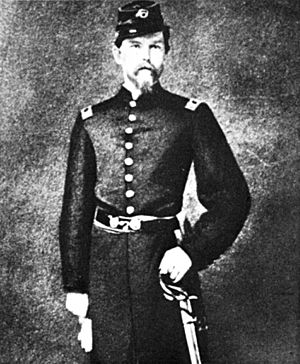
Irish Americans were famous for their service in the Irish Brigade. This brigade included the well-known "Fighting 69th" New York Infantry Regiment. The Brigade fought in almost every major battle in the Eastern Theater. It was known for its bravery. It reportedly had some of the highest casualties of any Union group. Irish soldiers also came from the British Empire. After the war, some veterans took part in the Fenian raids against British targets in Canada.
Other Nationalities in the Union
One of the first military groups formed when the war began was made of Polish immigrants. It was recruited by Brig. Gen. Włodzimierz Krzyżanowski. He was a veteran of the Greater Poland uprising of 1848. This group moved to New York City. It joined with other immigrant companies to form the 58th New York Infantry Regiment. It was officially called the Polish Legion. Krzyżanowski later commanded a brigade at Gettysburg. After the war, he became governor of Georgia.
Other nationalities also had their own regiments. One well-known group was the 79th New York Highlanders. It was formed in 1859. At first, it was only Scottish immigrants or their descendants. Soldiers wore kilts and bonnets and had bagpipes. During the First Battle of Bull Run, they wore tartan trews. This was to honor their colonel. As the war went on, the 79th allowed Irish, English, and other immigrants to join. Most of them had lived in the U.S. for years.
The Union army had many different nationalities. Sometimes, this caused communication problems because of language barriers. Many regiments had volunteers from Germany, Ireland, Italy, Poland, and other European countries. A good example was the 39th New York Infantry Regiment. It was also called the "Garibaldi Guard" after Italian revolutionary Giuseppe Garibaldi. This regiment was led by Hungarian colonel Frederick George D'Utassy. It had over a dozen nationalities, including Algerians, Turks, Slavs, Swiss, and Spaniards. Maj. Gen. Franz Sigel had his orders translated from German to Hungarian for his officers. Their reports were then translated into English for the rest of his command. Finally, they were translated back into German for him to review.
Some volunteers came from the British colony of Bermuda. Many were from the "colored" population. This term meant anyone not entirely of European heritage. Most served in special "colored" regiments. These were made up of African Americans. Examples include the 31st and the 54th Massachusetts. One notable Bermudian volunteer was First Sergeant Robert John Simmons of the 54th Massachusetts. He had served in the British Army before. He died in the Second Battle of Fort Wagner. This was the most famous action of the 54th Regiment.
Confederate Army: Foreign Soldiers
Thousands of immigrants who arrived before the war served in the Confederate Army. They had groups made up of Irish, Polish, German, and Mexican soldiers. These foreign groups were not as large or as important as the Union's. But they were also known for their bravery and loyalty.
Most foreign-born Confederate soldiers had lived in the southern U.S. for most of their lives. They were generally better integrated than their Northern counterparts. Many fought because they felt connected to their local community or state. They did not necessarily support slavery or leaving the Union. Others felt pressure from their communities. This was because the South needed more soldiers. By 1863, some Confederate leaders, like Georgia Governor Joseph E. Brown, even forced foreign nationals to join the war effort.
Irish and French Soldiers in the Confederacy
Irish soldiers were more common in the Confederacy than other nationalities. Most Irish immigrants supported the Democratic Party, which favored the Confederacy. The most famous foreign group was made of descendants of European communities in Louisiana. It was commanded by French Major General Count Camille Armand Jules Marie, Prince de Polignac. He was a veteran of the Crimean War. His troops affectionately called him "Prince Polecat." Polignac fought bravely in the Red River Campaign. He was especially noted for the Confederate victory at the Battle of Mansfield.
British Support for the Confederacy
Great Britain was strongly against slavery. But some people there had sympathy for the Confederacy. This was often due to economic interests in the South. They either sold war supplies or relied on American cotton. Some also admired the South's old-fashioned social structure. The Confederacy tried to get Britain to officially recognize and support them. This led to the Trent Affair, which almost caused a war between Britain and the Union.
Many British-born immigrants in the U.S. joined the Confederate military. They had different reasons. Some fought to defend the "Southern way of life" and "peculiar institution" (slavery). Others joined because of local ties or community pressure. Notable British subjects who joined the Confederacy included Henry Wemyss Feilden. He left the British Army to become a high-ranking officer in the Army of Tennessee. Another was William Watson. He served as a sergeant in the 3rd Louisiana Infantry. Later, he commanded ships that broke the Union blockade. Overall, British support, both at home and abroad, did not have a big impact on the war.
Bermuda's Role in the Confederacy
The Confederacy also had strong support from Bermuda. Bermuda had close family and trade ties with the South since the 1600s. St. George's was the main port where European war supplies were smuggled into the South. These goods came on blockade runners, which were also built in Britain. Cotton went the other way as payment. Many Bermudians became rich by trading with the Confederacy. One famous blockade runner was Thomas Leslie Outerbridge. Confederate agents worked openly in Bermuda. The Union's consul there was even attacked in the street. His flagpole was cut down on the Fourth of July.


